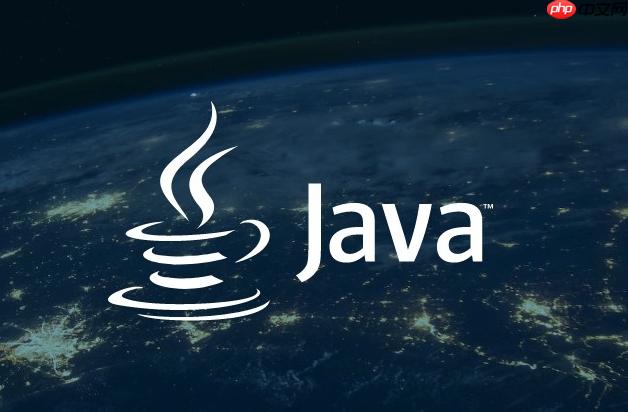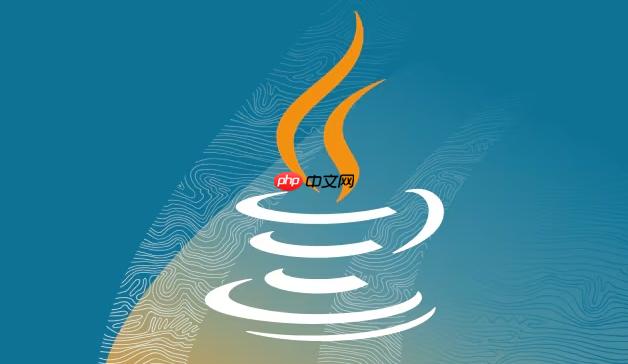java中completablefuture用于处理异步任务,提高程序响应性和效率。1.它代表异步计算结果,支持链式调用定义后续操作;2.通过supplyasync/runasync创建异步任务,completedfuture创建已完成任务;3.使用thenapply/thenaccept/thenrun实现链式操作,thencombine/thencompose组合多个任务;4.提供allof/anyof编排多任务执行;5.通过exceptionally/handle/whencomplete处理异常;6.相比future,其优势是非阻塞回调、丰富组合能力、简化线程管理;7.选择executorservice需根据任务类型决定,如forkjoinpool适用于cpu密集型任务;8.get()方法会阻塞,应优先使用then系列方法避免阻塞;9.使用ortimeout设置超时,配合exceptionally处理超时异常;10.cancel()方法可取消任务,但不一定能立即停止执行;11.与spring集成可通过@async声明异步方法,返回completablefuture。

Java中,CompletableFuture提供了一种强大的方式来处理异步任务,它允许你组合、编排和管理异步操作,从而提高程序的响应性和效率。

解决方案

CompletableFuture的核心在于它代表了一个异步计算的结果,你可以链式调用它的方法来定义任务完成后的后续操作。以下是一些关键用法:
立即学习“Java免费学习笔记(深入)”;
创建CompletableFuture:

CompletableFuture.supplyAsync(() -> ...): 用于执行一个有返回值的异步任务。CompletableFuture.runAsync(() -> ...): 用于执行一个没有返回值的异步任务。CompletableFuture.completedFuture(value): 创建一个已经完成的CompletableFuture,直接返回指定的值。// 异步执行一个耗时操作,返回字符串
CompletableFuture<String> future = CompletableFuture.supplyAsync(() -> {
// 模拟耗时操作
try {
Thread.sleep(1000);
} catch (InterruptedException e) {
Thread.currentThread().interrupt();
throw new RuntimeException(e);
}
return "Hello, Async World!";
});
// 异步执行一个无返回值操作
CompletableFuture<Void> voidFuture = CompletableFuture.runAsync(() -> {
System.out.println("Running async task...");
});链式操作:
thenApply(Function): 当CompletableFuture完成时,将结果传递给Function进行处理,返回一个新的CompletableFuture,包含Function的返回值。thenAccept(Consumer): 当CompletableFuture完成时,将结果传递给Consumer进行处理,没有返回值。thenRun(Runnable): 当CompletableFuture完成时,执行Runnable,没有返回值,也不关心CompletableFuture的结果。thenCombine(CompletableFuture, BiFunction): 当两个CompletableFuture都完成时,将它们的结果传递给BiFunction进行处理,返回一个新的CompletableFuture,包含BiFunction的返回值。thenCompose(Function): 类似于thenApply,但Function的返回值必须是另一个CompletableFuture,用于扁平化嵌套的CompletableFuture。exceptionally(Function): 当CompletableFuture抛出异常时,使用Function处理异常,返回一个新的CompletableFuture,包含Function的返回值。future.thenApply(result -> result.toUpperCase()) // 将结果转换为大写
.thenAccept(upperCaseResult -> System.out.println("Result: " + upperCaseResult)) // 打印结果
.exceptionally(ex -> {
System.err.println("Error: " + ex.getMessage());
return null; // 或者返回一个默认值
});组合多个CompletableFuture:
allOf(CompletableFuture...): 等待所有CompletableFuture完成。anyOf(CompletableFuture...): 只要有一个CompletableFuture完成,就返回。CompletableFuture<String> future1 = CompletableFuture.supplyAsync(() -> "Task 1");
CompletableFuture<String> future2 = CompletableFuture.supplyAsync(() -> "Task 2");
CompletableFuture<Void> allFutures = CompletableFuture.allOf(future1, future2);
allFutures.thenRun(() -> {
System.out.println("All tasks completed!");
try {
System.out.println("Result 1: " + future1.get());
System.out.println("Result 2: " + future2.get());
} catch (InterruptedException | ExecutionException e) {
e.printStackTrace();
}
});异常处理:
exceptionally(Function): 处理异常,返回一个备用值。handle(BiFunction): 处理结果或异常,返回一个新值。whenComplete(BiConsumer): 在完成时执行,无论成功还是失败,不修改结果。CompletableFuture<String> futureWithException = CompletableFuture.supplyAsync(() -> {
throw new RuntimeException("Something went wrong!");
});
futureWithException.exceptionally(ex -> {
System.err.println("Exception handled: " + ex.getMessage());
return "Default Value";
}).thenAccept(result -> System.out.println("Result: " + result));CompletableFuture相比Future的优势是什么?
CompletableFuture最大的优势在于它提供了非阻塞的API,允许你注册回调函数,在任务完成时自动执行,而不需要像Future那样通过get()方法阻塞等待结果。 此外,CompletableFuture提供了更丰富的组合和编排能力,可以方便地构建复杂的异步流程。 Future需要手动进行线程管理,而CompletableFuture可以使用ForkJoinPool或者自定义的ExecutorService,简化了线程的管理。
如何选择合适的ExecutorService?
选择合适的ExecutorService取决于你的应用场景。 如果是CPU密集型任务,可以使用ForkJoinPool.commonPool()或者创建一个固定大小的线程池。 如果是IO密集型任务,可以创建一个CachedThreadPool或者一个固定大小的线程池,并根据实际情况调整线程池的大小。 重要的是要监控线程池的使用情况,避免线程饥饿或线程过多导致性能下降。 也可以使用Executors.newVirtualThreadPerTaskExecutor()来创建虚拟线程池,但需要JDK21及以上。
CompletableFuture的get()方法会阻塞吗?如何避免阻塞?
CompletableFuture.get()方法会阻塞当前线程,直到结果可用或超时。 为了避免阻塞,应该尽量使用非阻塞的回调方法,例如thenApply、thenAccept、thenRun等。 如果必须使用get()方法,可以设置超时时间,例如get(timeout, TimeUnit),并在超时后进行处理。 另一种方法是使用join()方法,它会抛出一个未经检查的异常,不需要显式处理InterruptedException和ExecutionException。
如何处理CompletableFuture中的超时?
可以使用orTimeout(long, TimeUnit)方法来设置超时时间。 如果CompletableFuture在指定时间内没有完成,会抛出一个TimeoutException。 你可以使用exceptionally方法来处理这个异常。
CompletableFuture<String> futureWithTimeout = CompletableFuture.supplyAsync(() -> {
try {
Thread.sleep(2000); // 模拟耗时操作
} catch (InterruptedException e) {
Thread.currentThread().interrupt();
throw new RuntimeException(e);
}
return "Result";
}).orTimeout(1, TimeUnit.SECONDS);
futureWithTimeout.thenAccept(result -> System.out.println("Result: " + result))
.exceptionally(ex -> {
System.err.println("Timeout Exception: " + ex.getMessage());
return null;
});CompletableFuture的cancel()方法有什么作用?
CompletableFuture.cancel(boolean mayInterruptIfRunning)方法用于取消CompletableFuture的执行。 mayInterruptIfRunning参数指定是否中断正在运行的任务。 如果任务已经完成或已经被取消,调用此方法不会有任何效果。 取消一个CompletableFuture会使其抛出一个CancellationException。 需要注意的是,取消操作不一定能立即停止任务的执行,这取决于任务的具体实现。
CompletableFuture如何与Spring框架集成?
Spring框架提供了对CompletableFuture的良好支持。 你可以使用@Async注解将一个方法声明为异步方法,Spring会自动将其放入一个线程池中执行。 你还可以使用AsyncResult类来封装异步方法的返回值,并将其转换为CompletableFuture。
@Service
public class AsyncService {
@Async
public CompletableFuture<String> doSomethingAsync() {
// 执行异步操作
return CompletableFuture.completedFuture("Async Result");
}
}以上就是Java中如何用CompletableFuture处理异步任务的详细内容,更多请关注php中文网其它相关文章!

每个人都需要一台速度更快、更稳定的 PC。随着时间的推移,垃圾文件、旧注册表数据和不必要的后台进程会占用资源并降低性能。幸运的是,许多工具可以让 Windows 保持平稳运行。

Copyright 2014-2025 https://www.php.cn/ All Rights Reserved | php.cn | 湘ICP备2023035733号